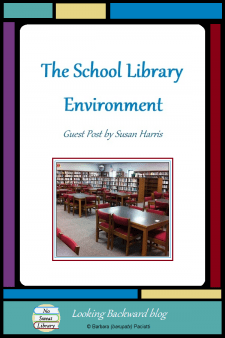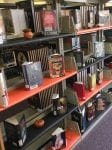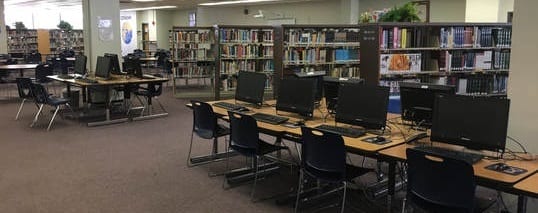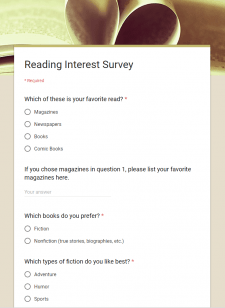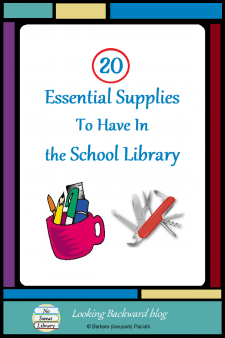 There are some things you just can’t live without…and that’s especially true in a school library. When we talk about supplies and tools for librarians, we usually mean for processing or repairing or circulating books.
There are some things you just can’t live without…and that’s especially true in a school library. When we talk about supplies and tools for librarians, we usually mean for processing or repairing or circulating books.
After 25 years in education, half of them in the library, I always keep these 20 essential supplies and tools on hand. Some are for me, for library management, but I make available certain materials specifically for students and teachers. If you haven’t discovered how useful these supplies and tools are, I know once you invest in them you’ll never regret it.
SUPPLIES FOR STUDENTS
We expect students to have their own school supplies, but often students don’t bring those to the library. In order to make sure students have writing implements to complete a library activity, I always have available:
 Golf pencils – These are the 4½” ones with no eraser. A box of 144 costs about $10 at any office supply store. I usually get a couple boxes at the start of school to last the whole year. Since kids don’t really like them (no eraser & hard to sharpen) they rarely carry them out of the library.
Golf pencils – These are the 4½” ones with no eraser. A box of 144 costs about $10 at any office supply store. I usually get a couple boxes at the start of school to last the whole year. Since kids don’t really like them (no eraser & hard to sharpen) they rarely carry them out of the library.- Small pencil sharpeners – These are perfect to sharpen golf pencils. I got a couple dozen for well under $1 apiece at the start of school one year in order to have one for each table plus a few extra. (I do need a few replacements each year because they break or “walk away”.) Students use them for their own pencils, too, and it’s a lot quieter than electric or hand crank sharpeners.
 Small plastic baskets – These 4”x5” baskets are so useful. I place one on each table, one between each pair of OPAC computers, and one at the circulation desk, so I have about 2 dozen. Each one holds a few golf pencils and a sharpener, along with several copies of my IT IS FOR ME checklist. They stack inside each other, so I can easily gather them up and store them on a shelf when they aren’t needed. I got mine at Target in the dollar aisle, but I’ve also seen 5″x5″ ones in cool colors at the dollar stores.
Small plastic baskets – These 4”x5” baskets are so useful. I place one on each table, one between each pair of OPAC computers, and one at the circulation desk, so I have about 2 dozen. Each one holds a few golf pencils and a sharpener, along with several copies of my IT IS FOR ME checklist. They stack inside each other, so I can easily gather them up and store them on a shelf when they aren’t needed. I got mine at Target in the dollar aisle, but I’ve also seen 5″x5″ ones in cool colors at the dollar stores.- Tiny sticky notes – The 1½”x2” ones are the perfect size to write down a call number, so I always have a pad in each of the baskets by the OPAC computers.
We also do more elaborate activities for Library Lessons, so I keep these student supplies stored in a closet, and set them out when needed:
- Color pencils – When we have a graphic organizer for a library activity, being able to use colors makes these simple worksheets into a fun experience for students. I get these very cheaply through my school district warehouse, and have one set of assorted colors per table. I’ve also seen golf-pencil-size ones in a dozen assorted colors for a buck and a half at the office supply store.
- Color markers – A great dollar store item, around a dollar for a set of 6-8, depending on the tip type. My middle schoolers prefer the skinny ones with pointed tips, but I also keep a supply of chisel-tip ones for poster projects. I discovered some of the cheap ones don’t bleed through paper as much as more expensive permanent markers, so a double benefit.
- Small scissors – I set out 4 per table so each student has a pair. I get the cheap utility ones through our warehouse, and because they’re ugly, the kids never take them out of the library. You can also find them for around 60¢ apiece at office supply stores, and they’re even cheaper in bulk.
 Small metal buckets – I use the 4” tall decorative ones on each table for scissors, color pencils, and markers. By having 2 per table—one for color pencils and one for markers—I can put scissors, if needed, into whichever one we’re using that day. I find these for about $1 at various places, especially at the start of school or just before the holidays.
Small metal buckets – I use the 4” tall decorative ones on each table for scissors, color pencils, and markers. By having 2 per table—one for color pencils and one for markers—I can put scissors, if needed, into whichever one we’re using that day. I find these for about $1 at various places, especially at the start of school or just before the holidays.- Glue sticks – For our cut-and-paste activities, tape just doesn’t work well, so I invest in 3 or 4 dozen glue sticks at the start of each school year. I put a couple in each table basket when we need them, and they’re so much cleaner than glue in a bottle. They last all year if kept in gallon sized zip-lock baggies when not being used.
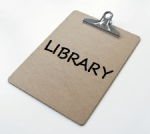 Clipboards – Another really cheap warehouse item, I have a storage bin full of these in the back room. I use them for my 7g orientation scavenger hunt, as well as other walk-around activities, to make it easier for students to write on worksheets. With a barcode on the bin cover, I can also loan them out to teachers.
Clipboards – Another really cheap warehouse item, I have a storage bin full of these in the back room. I use them for my 7g orientation scavenger hunt, as well as other walk-around activities, to make it easier for students to write on worksheets. With a barcode on the bin cover, I can also loan them out to teachers.
Taking care of, and setting out, these student supplies is an excellent task for student aides or to have a student work off the cost of a lost book. One day the baskets & buckets of supplies were out on tables when we had a faculty meeting, and my principal liked having them available for teachers, so she asked me to put them out for future meetings, too…and she’d cover the replenishment cost!
TOOLS FOR TEACHERS
In addition to those clipboards, there are a few other items teachers don’t need in their classrooms, but when they want them, I’m their one-stop-shop:
- Sidewalk chalk – I find big buckets of assorted colors for a couple bucks at different stores, so I always keep 2 or 3 of them on hand. Invariably in late spring a teacher wants to take students outdoors for an unplanned drawing activity, so they come to the library knowing that their handy-dandy librarian will have the chalk they need!
- Mirror – You know those hand-held mirrors with normal view on one side and close-up view on the other? Well, I’ve got one and it’s borrowed…all…the…time.
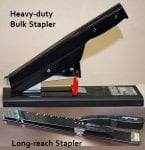 Specialty Staplers – I have 2 different ones: a long-reach stapler for stapling in the center of a sheet of letter or legal paper, the other a heavy-duty stapler for stapling up to 50 sheets of paper. I use the long-reach one quite a bit for the various library information booklets I create for teachers, aides, and volunteers. The biggest user of the heavy-duty one is the counselors!
Specialty Staplers – I have 2 different ones: a long-reach stapler for stapling in the center of a sheet of letter or legal paper, the other a heavy-duty stapler for stapling up to 50 sheets of paper. I use the long-reach one quite a bit for the various library information booklets I create for teachers, aides, and volunteers. The biggest user of the heavy-duty one is the counselors!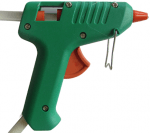 Electric glue gun & glue – I can’t tell you how often during my first couple years I was asked if I had one, so finally I purchased 2 small ones. I discovered they’re also a great way to make quick binding repairs for books with loose covers!
Electric glue gun & glue – I can’t tell you how often during my first couple years I was asked if I had one, so finally I purchased 2 small ones. I discovered they’re also a great way to make quick binding repairs for books with loose covers!- Extension cords – A school librarian can never have enough extension cords. I keep various lengths, from 2-pronged 6′ lightweight ones to 100′ 3-pronged heavy duty ones.
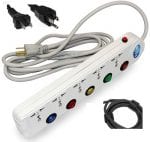 I also found it advantageous to keep a few surge protectors handy, especially ones with very long cords. And I barcoded every one of these for teacher checkout, because when I didn’t, I never got them back! Velcro ties in different lengths are very handy to keep each cord neatly wrapped.
I also found it advantageous to keep a few surge protectors handy, especially ones with very long cords. And I barcoded every one of these for teacher checkout, because when I didn’t, I never got them back! Velcro ties in different lengths are very handy to keep each cord neatly wrapped.
And here’s a video on the proper over-under way to wind up those long cords and cables we have in the library:
TOOLS FOR THE SCHOOL LIBRARIAN
The items listed here are not typically included during a library set-up, but once I acquired them, I realized how valuable they are:
- Desk bell – This sits on my computer presentation cart for use during lessons. I do a lot of discussion activities,
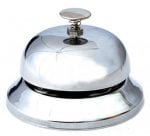 and this is the best way to regain students’ attention—high-pitched enough to be heard over voices, but not too loud. I give it 3 quick taps then wait, and within a few seconds students stop talking and turn back to me. It’s even distinctive enough to gain their attention when in the aisles browsing for books!
and this is the best way to regain students’ attention—high-pitched enough to be heard over voices, but not too loud. I give it 3 quick taps then wait, and within a few seconds students stop talking and turn back to me. It’s even distinctive enough to gain their attention when in the aisles browsing for books! - Paper cutter – This stays on a shelf behind my circulation desk because I use it so often for cutting apart sheets of overdues, my IT IS FOR ME checklist, cardstock bookmarks, and for trimming signage or paring down protective book covers.
 Reacher assistive tool – I’m average height, but I have trouble reaching DVDs and kits on shelves above a bank of computers along one wall, as well as things on top shelves in my back room. Once I got this gadget, I was amazed at how often I used it!
Reacher assistive tool – I’m average height, but I have trouble reaching DVDs and kits on shelves above a bank of computers along one wall, as well as things on top shelves in my back room. Once I got this gadget, I was amazed at how often I used it!- Engraving tool – When the school decided to purchase class sets of calculators for math classrooms and enough individual ones
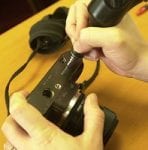 to check out to algebra students, they wanted me to keep track of them. I knew paper barcodes wouldn’t last long, so I invested in this tool and etched a barcode on the back side of every one. It works on headphone headpieces, too…in fact, I kinda went nuts etching so many things!
to check out to algebra students, they wanted me to keep track of them. I knew paper barcodes wouldn’t last long, so I invested in this tool and etched a barcode on the back side of every one. It works on headphone headpieces, too…in fact, I kinda went nuts etching so many things! - Tool box – I love tools. I’d rather visit a hardware store than a dress shop. I even keep a tiny (1¾”) bubble level on my key ring! I bought no-name-brand tools on sale, so I didn’t shell out much for these valuable items. Over the years I’ve fixed everything from audiocassette tapes to audio/video carts to tables and desks, but you know who uses my tool box the most? The custodians!
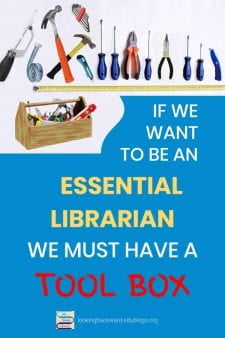 My library tool box holds:
My library tool box holds:
- set of screwdrivers- very small for digital equipment to huge for adjusting metal shelves
- small pairs of regular and needle-nosed pliers
- fold-up set of hex wrenches
- tiny hammer and larger lightweight one
- cutest little hacksaw for PVC pipe or lightweight metal
- cloth tape measure and metal locking one
- box cutter and razor-blade knife.
This completes my list of the 20 essentials that made my life so much easier as a School Librarian. It made students and teachers very happy, too…and isn’t that what “wise professional decisions” are for?


